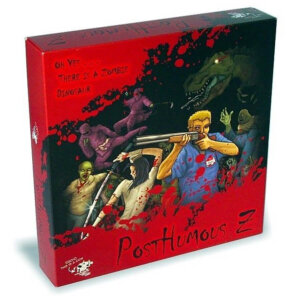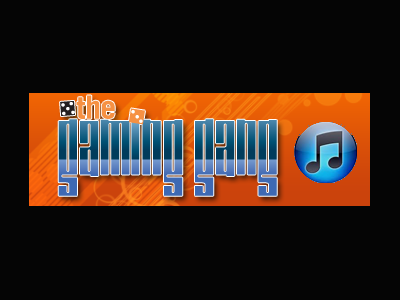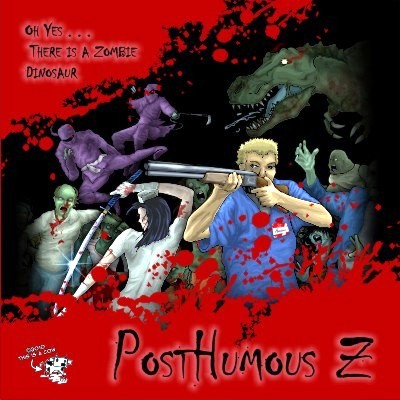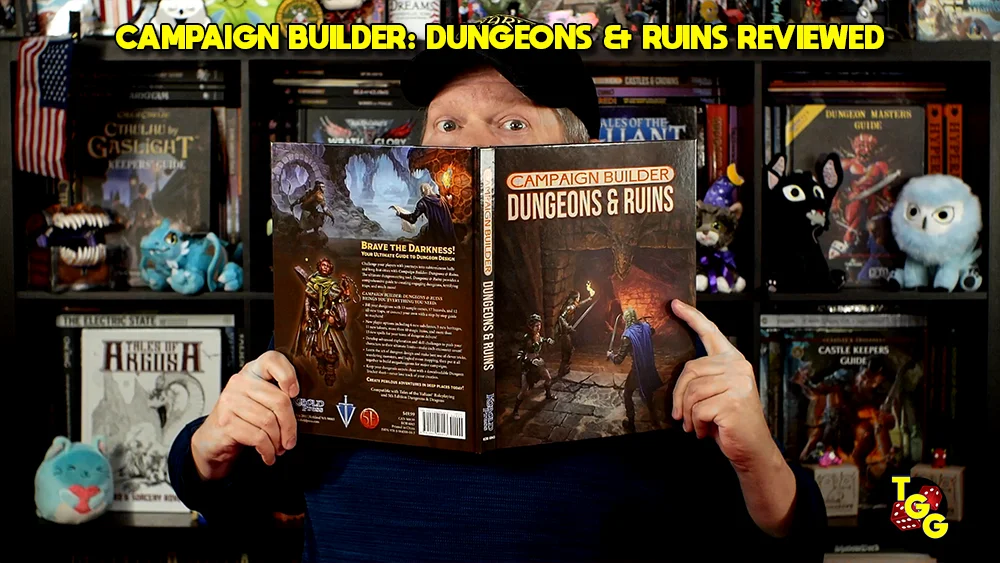Publisher: This is a Cow
Designer: Nathan Little
Year: 2011
Players: Two to ten players
Ages: 12+
Playing time: 60 minutes
MSRP: $75.00
Nathan Little, of This is a Cow, has designed a team based zombie apocalypse game which he is independently producing and distributing through his own website. Posthumous Z pits teams of players, representing zombies or survivors, in a battle to see if those handful of poor humans can make their way to safety – or relative safety I suppose.
You’ll find overall the components are especially nice when you keep in mind this is a self-published title. The rules booklet is well presented and the tiles, counters, stand ups and such are of good quality. One issue I did have is the cards included in the game. They are of rather thin stock and there are tons of cards to keep track of. Seriously, there is a boatload of cards included in the game (just under 300) and I would have concerns of how long they would hold up to extended play without sleeving them. Of course I’m a proponent of sleeving cards anyway so for myself it wasn’t much of a big deal. The artwork is neither a plus or minus to the design; none is exceptional but none gives you a headache either. Plus designer Little created all the work without any sort of graphic background so I won’t be to rough on him in that regard.Play breaks down to each player having a unique character or type of zombie. This is achieved, for humans, by the You, With, and But cards. For Zombies a theme is created with the They, That, and Hunger cards. These cards were discussed in some detail in our previous sneak peek piece we presented but suffice to say that each player will normally have something new to ponder as they create survivors or themes. These make for some interesting characters or zombie types and you’ll find there are hundreds upon hundreds of combinations which make each game more unique. The game 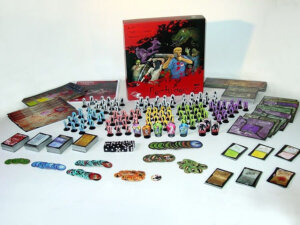
Humans, obviously, are trying to escape by traveling from one end of the board to the other while, also obvious, the zombies would like to snack on these unfortunates before they make their way out of town. The game opens with the zombies rather weak in number and scattered but the spawning of undead soon cranks up so the humans must work quickly to prevent being overwhelmed by sheer numbers. Actions performed by the survivors can also create noise which will add to the threat level of zombies focusing on that particular character and his or her followers, known as extras. This also helps the zombie player to spawn more zombies as well so it’s always a good idea to be as quiet as possible and resort to firearms as a last resort.
Unless the humans work together, eventually the zombie players will have enough undead (and unique kinds of undead) on the board making victory for the survivors impossible; if the zombie players need to spawn a zombie and there no zombies left to place on the board it is a zombie victory!
Humans win by escaping and zombies win by preventing that escape by leaving no survivors able to take actions (knocked down) in a turn. Or in other words, let the feeding frenzy commence!
Both survivors and zombies can also find or purchase additional cards that represent equipment or special benefits for either humans or zombies. Special setting cards can create a global situation or modifier that remains in play until another is played and the zombies also have boss characters that can make an appearance.
A zombie dinosaur anyone?
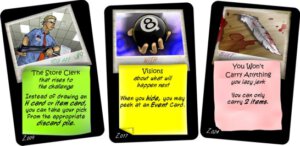
With all the variations as far as characters, zombies, settings, map lay out, and so on you’d think there would be loads of different strategies which players could bounce around. Sadly this doesn’t seem to be the case as each game boils down into the same sort of approaches for each team.
Humans need to stick together and move quickly; holding back or splitting up isn’t a recommended game plan for success. The living need to maneuver across the map as fast as possible before the zombie hordes manifest. The zombies, on the other hand, should simply focus on areas of escape and pump as many zombies into those locations as possible. If need be they can spread from there but you’ll find most games will boil down to the zombies just gathering in particular spots in order to block the survivors.
Something else that needs to be mentioned is the addition of the Spotlight Character and the Zombie Controller. These work almost as a first player token, or team leader, each turn but with additional benefits for those particular players. It’s important to note that zombie players don’t seem to have a whole lot to do if they aren’t the Controller for that turn. The Spotlight doesn’t seem as intrusive for the human players, as they tend to always have choices to make regardless if they’re the team leader that turn but zombie players really feel hamstrung.
I also felt there was more downtime involved than I expected after first reading through the rules. Granted, this is the only zombie game I’m aware of that can handle ten players, divided between the two teams, but with six players the zombie players were mentally checking out if they weren’t the controller that turn. Maybe a simple rule tweak to give less power to the ZC and more to other zombie players could alleviate this problem.
There is fun to be had in Posthumous Z and the battles can be rather intense while turning on an important die roll or use of a card. There are a lot of interesting bits of flavor and theme included in the game to flesh out the game play.
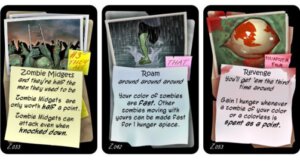
One final point I’ll make, and this really isn’t any sort of criticism of the game itself but more of a personal preference, is the tone of the rulebook. Sure, there’s a bit of a humorous feel to PHZ – especially when you take into account the randomly generated characters and zombie themes – yet the whole concept of the zombie genre is one of serious horror for the most part. PHZ boils down to humans killing zombies and vice versa. Two prime examples of the genre done right is The Walking Dead (both the comic and television series) or Max Brook’s World War Z; a zombie apocalypse played straight. Yet it seems as if the rule book written for every zombie board game I’ve run across, regardless of the title, is chock full of tongue in cheek humor. For myself, that takes you out of the moment as any true horror – zombie or otherwise – should be a punch in the gut. Unless you’re playing it as spoof or satire then you should expect more serious writing.
We are, after all, talking about the dead returning to the land of the living in which to slaughter those who still draw breath.
In the end, is Posthumous Z a good game? Well, I can say that it’s an impressive achievement for a single person to have produced and the quality of what you get, outside of my concerns with the cards, is very good. Toss in that it’s the only zombie game that I know of that can field ten players and you might want to take a serious look if you’re into the mania currently in vogue. It’s possible that I didn’t get enough game plays in to see what other strategies might be employed by either side but my gut reaction is that you’re still looking at a mad dash for the humans and blocking actions by the zombies. With a few minor changes to the rules I can see a dramatic reduction in the downtime, especially for the non-ZC zombie players, as well as giving those same non-ZC players more to do on the zombie side.
All it would take are a few tweaks here or there and I could see bumping PHZ by a full point, or a little more, in the final score.
[rwp-review id=”0″]
- SOLO BORG is Up for Crowdfunding on Kickstarter - Apr 11, 2025
- Dungeon Crawl Classics: Grave Robbers of Thracia to Land in Stores in May - Apr 11, 2025
- Score Big Savings on the Between Clouds Roleplaying Game - Apr 11, 2025


